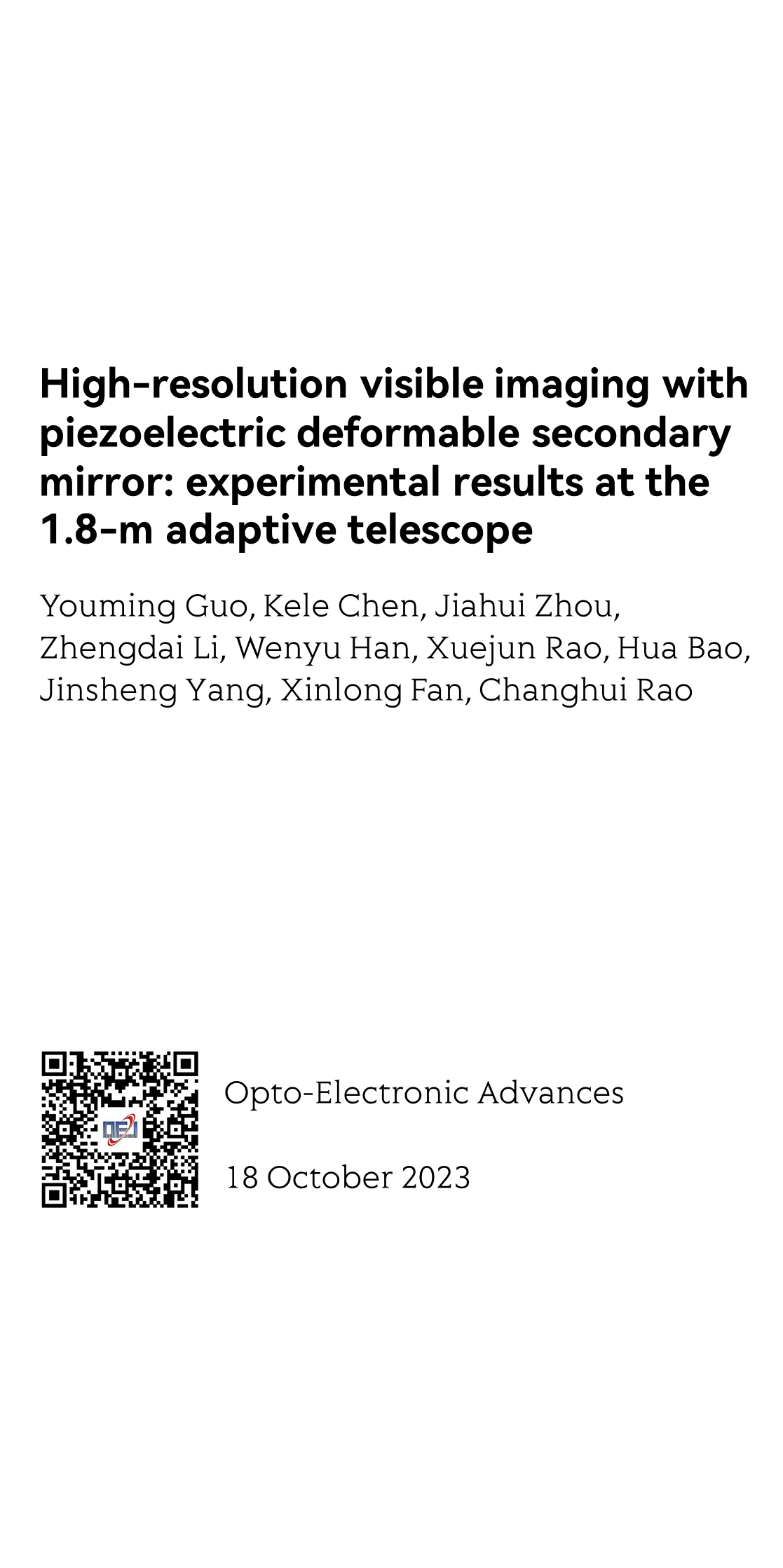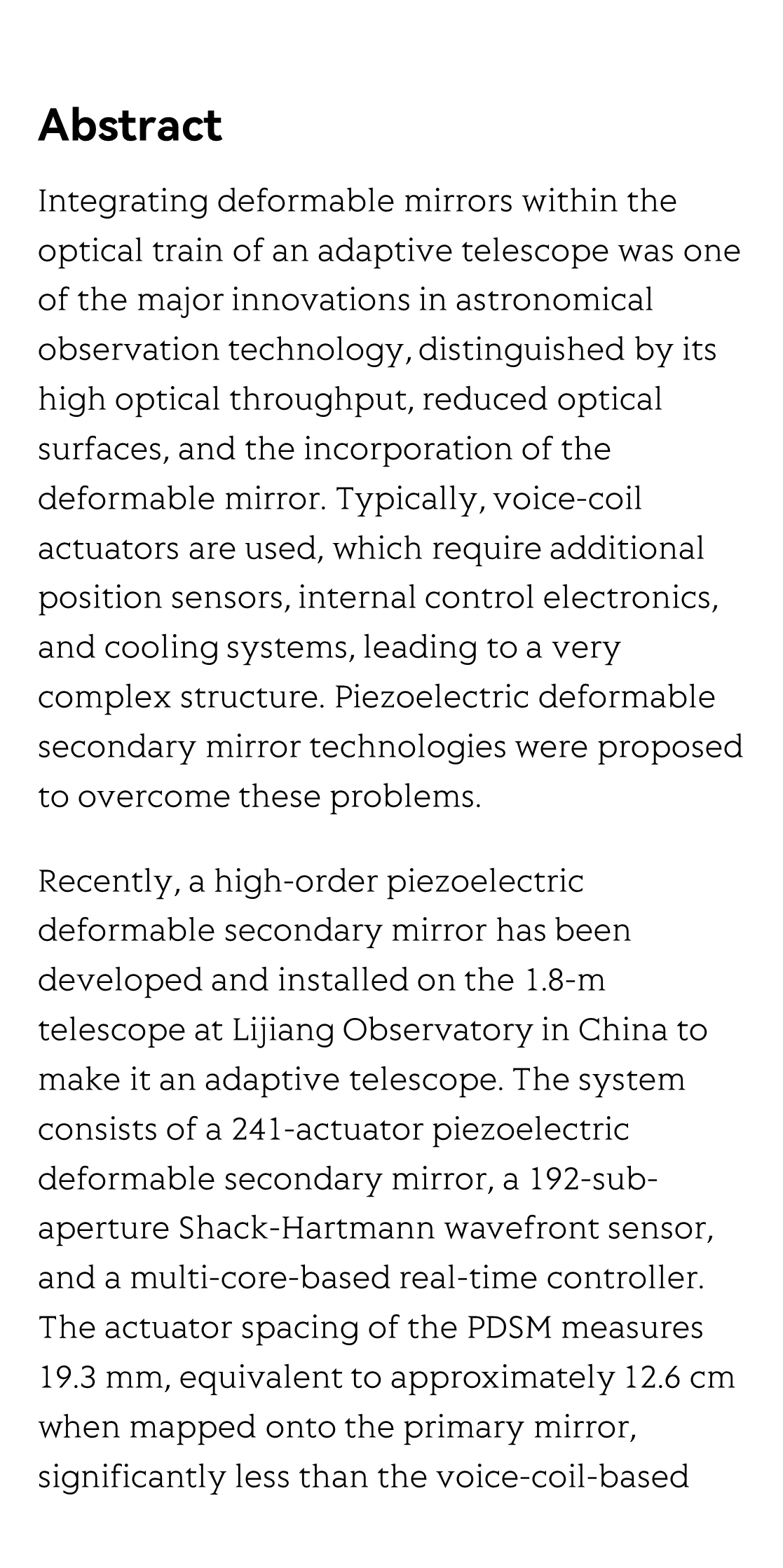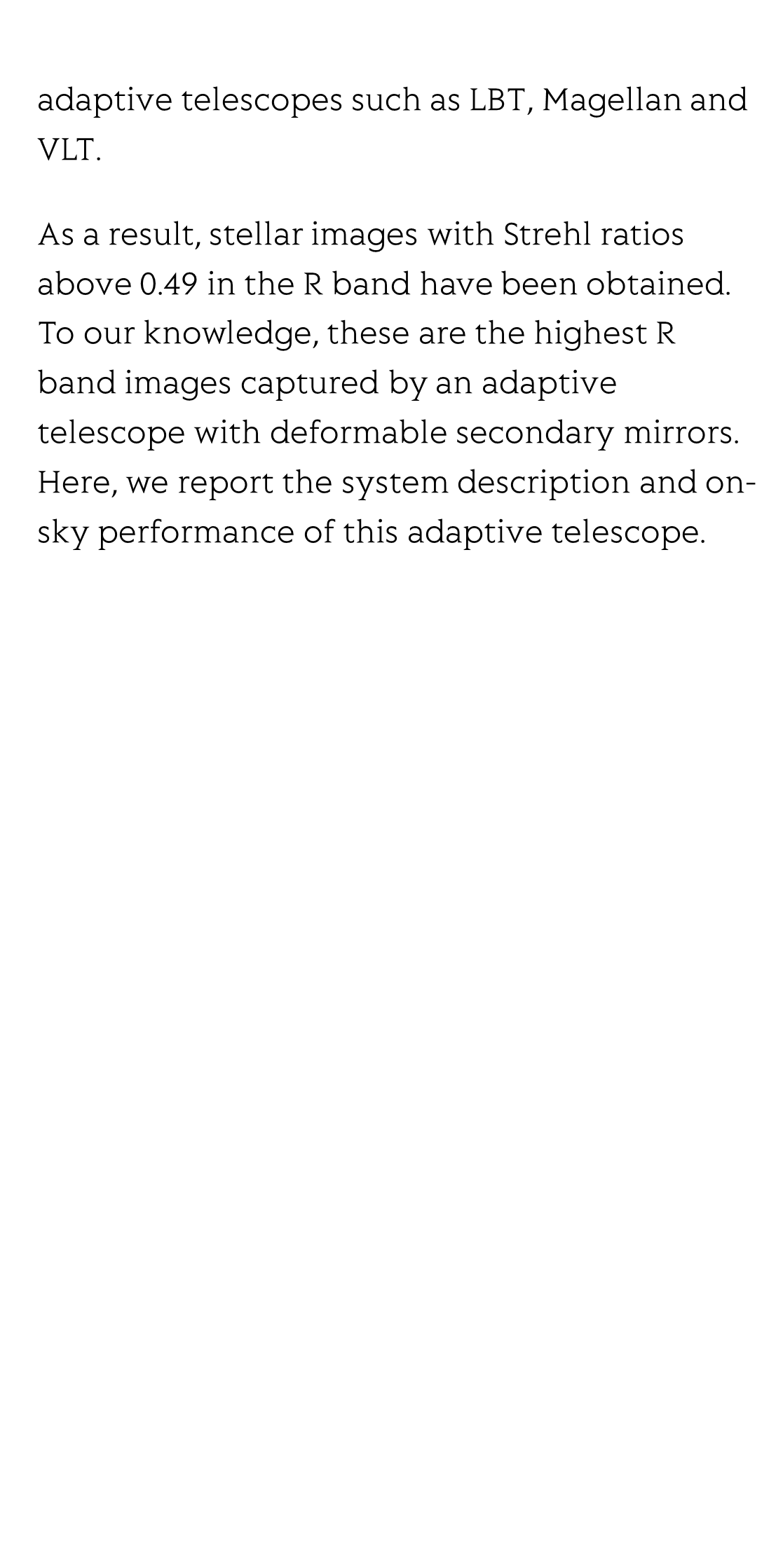(Peer-Reviewed) High-resolution visible imaging with piezoelectric deformable secondary mirror: experimental results at the 1.8-m adaptive telescope
Youming Guo 郭友明 ¹ ² ³ ⁴, Kele Chen 陈克乐 ¹ ² ³ ⁴ ⁵, Jiahui Zhou 周家辉 ¹ ² ³ ⁴, Zhengdai Li 李政岱 ¹ ² ³ ⁴, Wenyu Han 韩文雨 ¹ ² ³ ⁴, Xuejun Rao 饶学军 ¹ ² ³, Hua Bao 鲍华 ¹ ² ³, Jinsheng Yang 杨金生 ¹ ² ³, Xinlong Fan 樊新龙 ¹ ² ³, Changhui Rao 饶长辉 ¹ ² ³ ⁴
¹ The Key Laboratory on Adaptive Optics, Chinese Academy of Sciences, Chengdu 610209, China
中国 成都 中国科学院自适应光学重点实验室
² Institute of Optics and Electronics, Chinese Academy of Sciences, Chengdu 610209, China
中国 成都 中国科学院光电技术研究所
³ University of Chinese Academy of Sciences, Beijing 100049, China
中国 北京 中国科学院大学
⁴ School of Electronic, Electrical and Commutation Engineering, University of Chinese Academy of Science, Beijing 100049, China
中国 北京 中国科学院大学电子电气与通信工程学院
⁵ National Key Laboratory of Optical Field Manipulation Science and Technology, Chengdu 610209, China
中国 成都 中国科学院 光场调控科学技术全国重点实验室
Opto-Electronic Advances
, 2023-10-18
Abstract
Integrating deformable mirrors within the optical train of an adaptive telescope was one of the major innovations in astronomical observation technology, distinguished by its high optical throughput, reduced optical surfaces, and the incorporation of the deformable mirror. Typically, voice-coil actuators are used, which require additional position sensors, internal control electronics, and cooling systems, leading to a very complex structure. Piezoelectric deformable secondary mirror technologies were proposed to overcome these problems.
Recently, a high-order piezoelectric deformable secondary mirror has been developed and installed on the 1.8-m telescope at Lijiang Observatory in China to make it an adaptive telescope. The system consists of a 241-actuator piezoelectric deformable secondary mirror, a 192-sub-aperture Shack-Hartmann wavefront sensor, and a multi-core-based real-time controller. The actuator spacing of the PDSM measures 19.3 mm, equivalent to approximately 12.6 cm when mapped onto the primary mirror, significantly less than the voice-coil-based adaptive telescopes such as LBT, Magellan and VLT.
As a result, stellar images with Strehl ratios above 0.49 in the R band have been obtained. To our knowledge, these are the highest R band images captured by an adaptive telescope with deformable secondary mirrors. Here, we report the system description and on-sky performance of this adaptive telescope.
Review for wireless communication technology based on digital encoding metasurfaces
Haojie Zhan, Manna Gu, Ying Tian, Huizhen Feng, Mingmin Zhu, Haomiao Zhou, Yongxing Jin, Ying Tang, Chenxia Li, Bo Fang, Zhi Hong, Xufeng Jing, Le Wang
Opto-Electronic Advances
2025-07-17
Multiphoton intravital microscopy in small animals of long-term mitochondrial dynamics based on super‐resolution radial fluctuations
Saeed Bohlooli Darian, Jeongmin Oh, Bjorn Paulson, Minju Cho, Globinna Kim, Eunyoung Tak, Inki Kim, Chan-Gi Pack, Jung-Man Namgoong, In-Jeoung Baek, Jun Ki Kim
Opto-Electronic Advances
2025-07-17
Non-volatile tunable multispectral compatible infrared camouflage based on the infrared radiation characteristics of Rosaceae plants
Xin Li, Xinye Liao, Junxiang Zeng, Zao Yi, Xin He, Jiagui Wu, Huan Chen, Zhaojian Zhang, Yang Yu, Zhengfu Zhang, Sha Huang, Junbo Yang
Opto-Electronic Advances
2025-07-09
CW laser damage of ceramics induced by air filament
Chuan Guo, Kai Li, Zelin Liu, Yuyang Chen, Junyang Xu, Zhou Li, Wenda Cui, Changqing Song, Cong Wang, Xianshi Jia, Ji'an Duan, Kai Han
Opto-Electronic Advances
2025-06-27
Operando monitoring of state of health for lithium battery via fiber optic ultrasound imaging system
Chen Geng, Wang Anqi, Zhang Yi, Zhang Fujun, Xu Dongchen, Liu Yueqi, Zhang Zhi, Yan Zhijun, Li Zhen, Li Hao, Sun Qizhen
Opto-Electronic Science
2025-06-25
Observation of polaronic state assisted sub-bandgap saturable absorption
Li Zhou, Yiduo Wang, Jianlong Kang, Xin Li, Quan Long, Xianming Zhong, Zhihui Chen, Chuanjia Tong, Keqiang Chen, Zi-Lan Deng, Zhengwei Zhang, Chuan-Cun Shu, Yongbo Yuan, Xiang Ni, Si Xiao, Xiangping Li, Yingwei Wang, Jun He
Opto-Electronic Advances
2025-06-19







